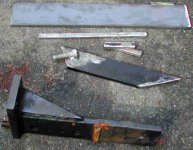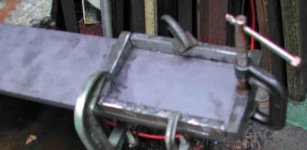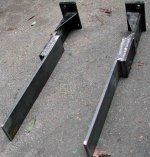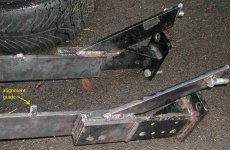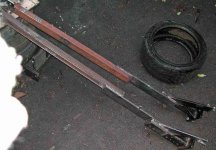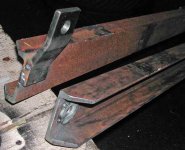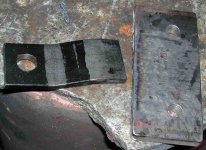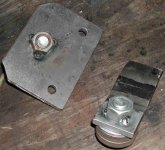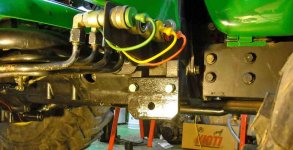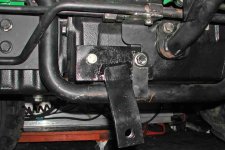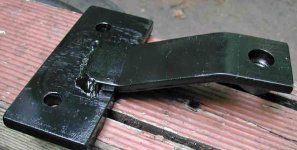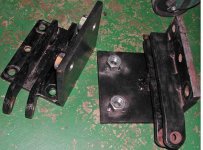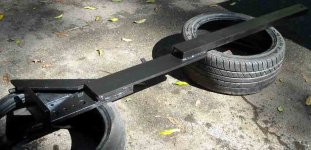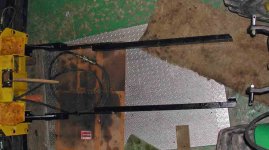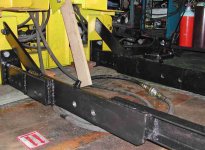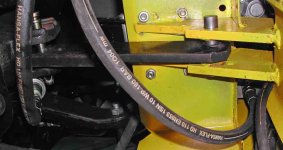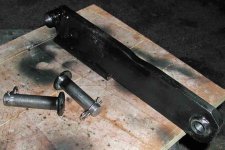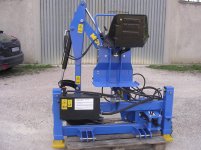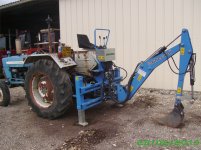dfkrug
Super Member
- Joined
- Feb 3, 2004
- Messages
- 7,679
- Location
- Santa Cruz Mtns, CA
- Tractor
- 05 Kioti CK30HST w/ Prairie Dog backhoe, XN08 mini-X
My strategy is to go with a ladder-style subframe with no "rungs", and
an enhanced toplink.
In the first photo, I show the hoe-side 3-pt bracket that comes with
the hoe with the side support cut off. This is very hefty 3.5" x 5/8"
steel. I bought some 1/2" x 4" A36 plate steel (shown) to extend the sides
and to provide the support surface that gets bolted to the modified
ROPS brackets.
Since the width of the ROPS bracket spacing is less than the spacing of
the 3-pt bracket, I will first need to provide a jog of 3/4" on each
frame rail. The pieces of 1/2" x 3/4" steel will be used for this purpose.
An easier approach might be to buy 2 much longer pieces of 1/2 x 4"
plate, and attach them directly to the hoe. This would require putting
2 bends in each rail, but such bends would require rungs to resist
twisting. I have made these bends before, using my press, and they do
look nice. At $5/ft, this plate is not expensive, but I like to reuse
existing materials if it makes sense.
In the 2nd photo, I am ready to weld my small bits of 1/2" steel onto the
plate. To manage heat distortion, I welded the end piece on first, then
worked my way toward the other end of the 2-ft long member. While it
was VERY hot, I welded it to the 3-pt bracket. If not carefull, the 1/2"
plate will bend and require tweaking on a press to straighten it out. (Ask
me how I learned this.) I was able to keep the bend under 1/16" over
the full 2 feet. You can't really do this if you tack-weld it all first.
The 3rd/4th photos shows the result. I welded on 2 small alignment guides so
that the hoe/subframe assembly will self-center between the ROPS
brackets during installation. The angular braces are 9/16x2.5" with a
welded on 3/4" bolt to add stiffness, and to make use of the last mounting
hole on the hoe. All of this was bolted to the hoe, then welded. One
came out perfect, and the other took a bit of tweaking to get the bolts
to line up right.
an enhanced toplink.
In the first photo, I show the hoe-side 3-pt bracket that comes with
the hoe with the side support cut off. This is very hefty 3.5" x 5/8"
steel. I bought some 1/2" x 4" A36 plate steel (shown) to extend the sides
and to provide the support surface that gets bolted to the modified
ROPS brackets.
Since the width of the ROPS bracket spacing is less than the spacing of
the 3-pt bracket, I will first need to provide a jog of 3/4" on each
frame rail. The pieces of 1/2" x 3/4" steel will be used for this purpose.
An easier approach might be to buy 2 much longer pieces of 1/2 x 4"
plate, and attach them directly to the hoe. This would require putting
2 bends in each rail, but such bends would require rungs to resist
twisting. I have made these bends before, using my press, and they do
look nice. At $5/ft, this plate is not expensive, but I like to reuse
existing materials if it makes sense.
In the 2nd photo, I am ready to weld my small bits of 1/2" steel onto the
plate. To manage heat distortion, I welded the end piece on first, then
worked my way toward the other end of the 2-ft long member. While it
was VERY hot, I welded it to the 3-pt bracket. If not carefull, the 1/2"
plate will bend and require tweaking on a press to straighten it out. (Ask
me how I learned this.) I was able to keep the bend under 1/16" over
the full 2 feet. You can't really do this if you tack-weld it all first.
The 3rd/4th photos shows the result. I welded on 2 small alignment guides so
that the hoe/subframe assembly will self-center between the ROPS
brackets during installation. The angular braces are 9/16x2.5" with a
welded on 3/4" bolt to add stiffness, and to make use of the last mounting
hole on the hoe. All of this was bolted to the hoe, then welded. One
came out perfect, and the other took a bit of tweaking to get the bolts
to line up right.
